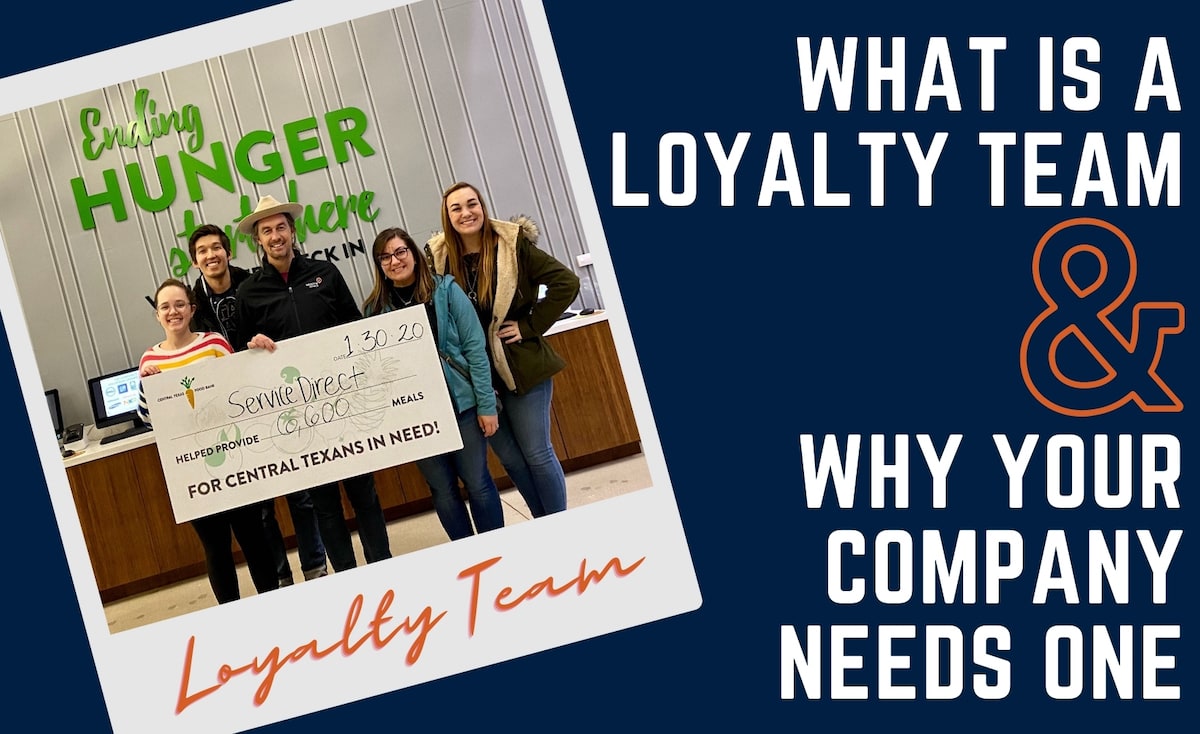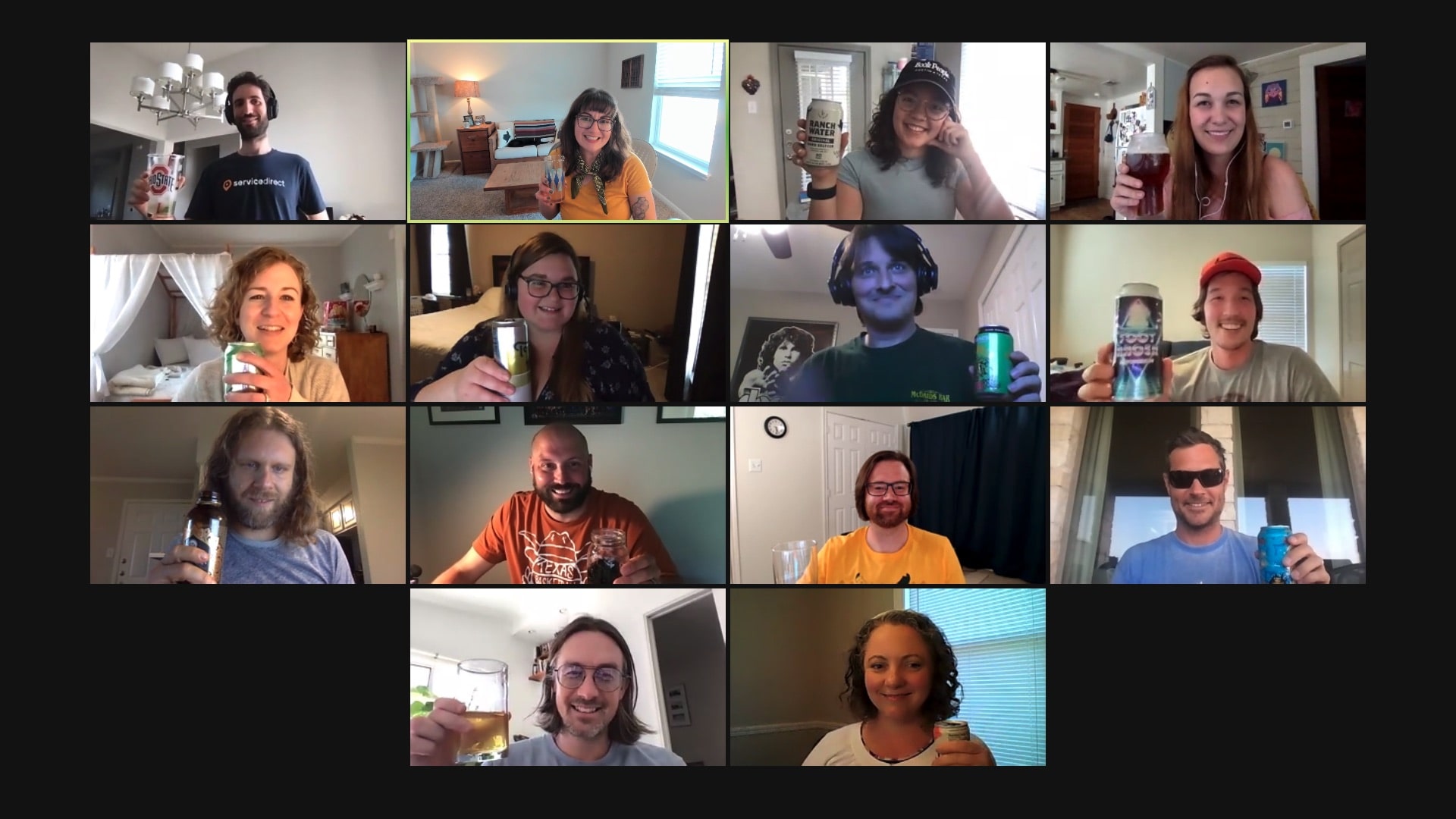What Is An Employee Loyalty Team And Why Your Company Needs One
By definition, loyalty is a strong feeling of allegiance or support; but as most people know there’s a lot more to loyalty than that. With friends, loyalty can mean sticking with your plans. With family, it can be shown by attending siblings’ recitals and athletic events. In the workplace, loyalty can be pride in the company you work for or unwavering resolve to do the best job you can. Ultimately, loyalty is something many people exhibit every day to show commitment, care, and dedication.
At Service Direct, we are fortunate to have a cohort of employees who show their loyalty to our business every day, which is why we wanted to do something to show our employees that we are loyal to them as well. From there, the idea of our Loyalty Team was born.
What exactly is a Loyalty Team? The fact of the matter is that it can look different for every company depending on what exactly that company’s goals are. Our Loyalty Team is a small group of people who have volunteered to spend a portion of their work time planning non-mandatory monthly activities to keep Service Direct’s employees engaged with one another while having a good time.

Employee Satisfaction Before and During the Pandemic
The first thing to know about our Loyalty Team is that we implemented it before we had any idea that we would be transitioning to a fully-remote company for the better part of two years. Initially, we simply wanted to make sure our employees felt valued and excited about working at Service Direct. With 46% of job seekers citing company culture as very important and the fact that “happy” employees are 31% more productive than their “unhappy” counterparts, it’s not too difficult to see why we wanted to prioritize engagement and improve company culture.
It’s certainly not a secret that culture initiatives make a company more desirable to the majority of job seekers and employees; in fact, it makes sense. But as a small business, it can be easy for culture to fall lower and lower on the list of priorities, especially if you are actively growing and might not have adequate resources to prioritize company culture. Looking back, we are thankful that we decided to implement our Loyalty Team before the COVID-19 pandemic. The team played a huge role in keeping employees happy and engaged during these uncertain times, and we are excited to see how it continues to improve the work lives of our employees.
Why We Implemented an Employee Loyalty Team and Why You Should Too
As the 2010s came to an end, we at Service Direct were very excited to be growing quite rapidly. After operating as a very small team for a large part of the company’s history, the long-awaited growth we were seeing was both encouraging and daunting. As exciting as that growth was, we began to realize that in order to ensure our employees continued to experience a fun, exciting company culture we needed to find a way to hold ourselves accountable. We also found that the responsibility of planning activities and events was falling onto one person rather than being shared by multiple individuals. In order to combat that, a small group of people were chosen—after volunteering—to be a part of the inaugural Service Direct Loyalty Team in December 2019.
Benefits of a Loyalty Team
-
- No matter how the workplace changes, it can keep company culture activities top of mind.
- It helps distribute the level of effort required to execute said culture activities.
- It keeps the company accountable for making sure culture and employee happiness is a top priority.
- It fosters team building and inter-departmental communication that might otherwise not be achieved.
- It can provide an additional sense of purpose for team members that are participating in the loyalty team.
- It ensures the company is actually doing activities that your team wants to do and finds fun and valuable rather than what one person wants.
Over the past 20 months, our Loyalty Team has coordinated trivia nights and volunteer events. With their organizing, we have hosted virtual coffee breaks, breathing exercises, and 30-minute yoga sessions. And personally, as an employee at Service Direct that is not a member of the Loyalty Team, I can confidently say that their efforts have had a huge impact on how much I enjoy my job and working for Service Direct. When we used to work in the office I really enjoyed the daily interactions I’d have with coworkers over lunch or a cup of coffee and our Loyalty Team has really helped keep those moments alive while we’ve all been working from home. But don’t just take my word for it:
“The transition from in-person to fully remote was hard on some, including me, and without the Loyalty Team, I am not sure if I would have been as calm and felt as connected with everyone. Additionally, we consider many circumstances now when planning events and activities by being more inclusive and giving employees with odd schedules or busy days an opportunity to join in on the fun by planning multiple, diverse events.”
- Ariel Owens, Customer Support Manager & Loyalty Team Member
“It's easy to get caught up in the day-to-day tasks and lose touch with things that are important parts of taking care of ourselves. The Loyalty Team’s efforts to put those impactful things into simple fun challenges involving tasks like writing someone a thank you letter, drinking more water, or taking time to meditate really helped me realize how beneficial it is to let yourself take a break and do something joyful or relaxing that helps you feel refreshed to continue your day.”
- Taylor Stafford, Content Strategist
The simplest reason to start your own Loyalty Team is that it makes your employees feel valued and excited to work for your company, especially if you are continuing to stay fully remote or partially remote as we move into 2022.
Steps to Get Your Loyalty Team Started
In 2019 when we began discussing the idea of a Loyalty Team, there were more questions than answers. What would the budget look like? How would we decide who would be on the Loyalty Team? In what ways could we ensure that the Loyalty Team and their efforts were prioritized by the company? Some of the questions would get ironed in the first 6 months of the Loyalty Team but others needed to be answered before we could go further. Here are your first steps to getting a Loyalty Team up and running.
-
- Ensure you have executive buy-in. This is a crucial step to sort out before moving any further with your Loyalty Team. The executives at your company should be committed to the success of the Loyalty Team in order to ensure adequate funding is available as well as any other support the team may need.
-
- Iron out as many specifics as possible. There will of course be many questions that will not be answered until the Loyalty Team is well underway, but your employees will want to know as many details as possible. It’s important to outline the expectations as best as you can so that when you announce the Team people feel confident knowing what will be expected of them if they apply.
-
- Announce the Loyalty Team to the company. It’s important to make an announcement about the team so that employees have plenty of time to consider signing up. In this announcement, you’ll want to give as many specifics as you can regarding the level of commitment and longevity of someone’s appointment on the Loyalty Team.
-
- Create a short, informal way for employees to apply. You’ll make the application available to anyone who wants to apply and encourage them to do so. This application should have a handful of questions to help the applicant understand a little better what it means to be a member of the Loyalty Team. Keep in mind that you may need to send reminders to nudge people to apply if you aren’t receiving the volume of applications that you want.
-
- Create necessary communication channels. Once you choose the inaugural members of the Loyalty Team you will need to create a communication channel to stay in touch about meetings and events. If you use a tool like Slack, these channels are easy to create and are a great way to keep everyone on the Team informed.
-
- Schedule a regular meeting cadence and hold people accountable. As with many things of this nature, the greatest chance that the Loyalty Team will not stick occurs at the inception of the Team. If everyone is not committed to meeting regularly and prioritizing events, there is a chance the Loyalty Team will fade away. To help prevent this, you’ll want to establish a regular meeting schedule so that members can plan around the Loyalty Team meetings and will know what to expect.
-
- Make the Loyalty Team and its objectives part of your company’s yearly or quarterly goals. While it’s not necessarily essential, we have found that adding the Loyalty Team’s goals to Service Direct’s yearly OKRs helps hold everyone accountable. This also shows current and potential employees that we take their well-being and happiness just as seriously as we take our business goals.
It’s important to remember that creating a Loyalty Team for your business is not a one-size-fits-all scenario. Every company will have differences that will affect how exactly the formation and continuation of the Loyalty Team will look. But if you are thinking about starting your own Loyalty Team these steps are a great place to start thinking about what you need and how to go about getting it.
Tips for a Successful Loyalty Team Based on Our Experience
After nearly two years we are able to look back on the Loyalty Team so far and look at its many successes while learning from the few shortcomings. We have learned so much and could have never foreseen how beneficial this Team would be to the overall happiness of our employees. As the pandemic led to shutdowns across the globe, our company has thrived as a fully-remote workplace, and our employees who were fully remote before the shutdown has formed connections with coworkers that may not have happened without the Loyalty Team.
“As a team member who has been fully remote for almost four years and a manager of a fully remote team, loyalty team events are some of the only ways I’m able to connect with folks across teams. There are no water cooler moments, hallway “how are you’s?”, or lunchtime chats that help make us feel like a part of the team on a daily basis. But getting to plan and participate in events that feel like they are developed just for the purpose of connecting ensures that we are encouraged and valued as members of the whole team.”
- Alycia Cameron, Quality Assurance Team Leader and Loyalty Team Member
Here are some basic recommendations, best practices, and things to consider for creating your own Employee Loyalty Team:
-
- Have representation from as many teams or departments as possible.
- Let anyone volunteer to be on the team and establish a set length of time that people will be on the team. We rotate Loyalty Team members quarterly.
- Have someone who has budget approval on the team so that team members have a clear idea of what kind of events they can plan financially.
- Have a top leader or executive on board to get efficient approval of big events and activities. Executives are busy people and having one on the Loyalty Team plays a huge role in speeding up the approval process.
- Find a sweet spot for how often you want to meet based on availability and goals. It’s important to be realistic about how much time team members have to put into the Loyalty Team while also ensuring that you meet often enough to have regular events.
- Send out regular team surveys to gather a backlog of activity ideas and figure out what employees actually want to do. You may be surprised how many people are interested in a specific activity that you otherwise wouldn’t have tried.
- Manage all of your initiatives in a project manager to keep track of plans. We use Asana to manage Loyalty Team projects in an easy-to-understand format.
- Set specific goals for the month or quarter about what the loyalty team wants to achieve. It’s okay if you don’t always meet these goals, but establishing them is key to staying on top of everything.
- Choose a point person on the team to own each activity or initiative that is scheduled. This person should be someone who is excited about the specific activity and has the availability to help it come to fruition.
Ultimately, the Loyalty Team has made an undeniable impact in how the employees at Service Direct interact with one another both in and out of the office. Especially with the last year and a half of quarantine and transitioning to a large remote office, the Loyalty Team has made our company stronger in ways we would have never imagined. Connections are so important to living happy, content lives, and connecting with people at work dramatically improves overall company satisfaction. When it comes to articulating why exactly a company should put as much effort as possible into loyalty and connections, John Turpin, Service Direct’s CTO and co-founder said it best.
“Any time and energy spent towards Loyalty Team efforts has excellent returns for quality of communication, trust between people. When people care about each other, they will listen better, have more compassion, and be more willing to help. Life and running a business are not a smooth road—I want to be going with folks who want to be there supporting me and each other. I don’t want to be on a difficult journey with people who I don’t really know well.”
-John Turpin, Service Direct’s CTO and Co-Founder




